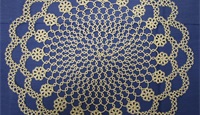
Applicant:
Municipality of Karavas
Communities Concerned - Bearers of the element:
Embroiderers, Muncipality of Karavas, Cultural Foundation of Municipality of Karavas, Refugee Association "Karavas", Municipal Youth Council of Karavas.
Domain of Intangible Cultural Heritage:
Traditional craftsmanship
Date of inscription:
2016
Geographical distribution:
The art of fervolites lace was mainly practiced in Karavas, in the Kyrenia district as well as in neighbouring communities, such as in Kyrenia and Lapithos. After 1974, the women who used to create this art were dispersed throughout Cyprus and even abroad. The practice of fervolites lace-making can also be found in Omodos, in the Limassol district.
Brief description:
The word ‘fervolites’ originates from France, where a similar lace is called frivolité, meaning something that is created with circles. This lace can also be found, with a different structure, shape and manufacturing method, in other European countries such as Italy, Spain and England. In the medieval era, there used to be a manor in Karavas that belonged to the family of Mattheos Paleologos, the wife of whom came from a family of French nobles. It seems the art of fervolites lace was passed on to the Cypriot women who came into contact with these nobles. With the passage of time, the Cypriot fervolites lace took on its own character and traditional Cypriot shapes and motifs. While in other countries they use different colours and sometimes two shuttles, in Cyprus they exclusively use the makoukoudi (refers to a small weaving row) of 2x6cm, a needle, scissors and bobbin thread in the colour beige or white (traditional).
In more recent times, embroiderers would make fervolites race using different colours, depending on their taste and home décor.
The main motif is the flower. Another commonly used motif is the small circles, feggarka (‘moons’), which are linked together to create square, rectangular, rhombus or round formations.
Besides being used for dowries, fervolites lace was also a commercial commodity. In the old days, the women of Karavas would gather together to embroidery and visit other villages to sell them. In the early 20th century, embroidery sellers, kentitarides, would purchase them and sell them on. The kentitarides would visit the best embroiderers at their home regularly and purchase sets of napkins, usually one big, six medium-sized and six small. When tourism started to develop, fervolites lace was very sought after, particularly in Kyrenia.
Today, a great effort is being made by all of Karavas’ organised bodies to keep the art of fervolites alive, despite the displacement of the community. Within this context, exhibitions and lectures are held, and the art of fervolites is regularly taught by experienced embroiderers from Karavas.